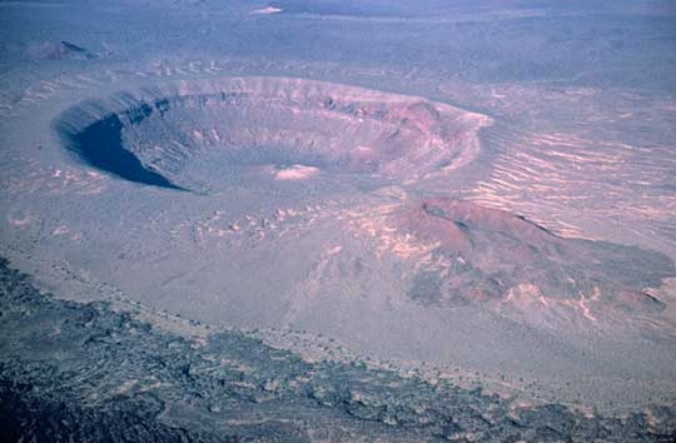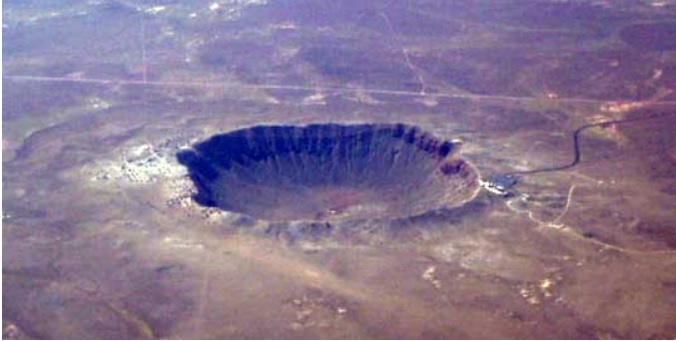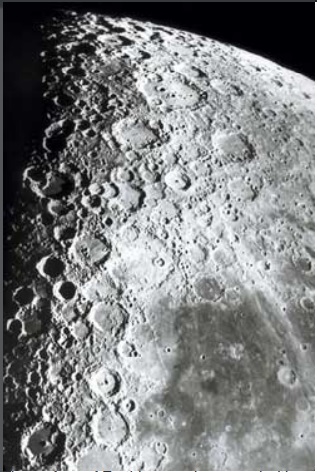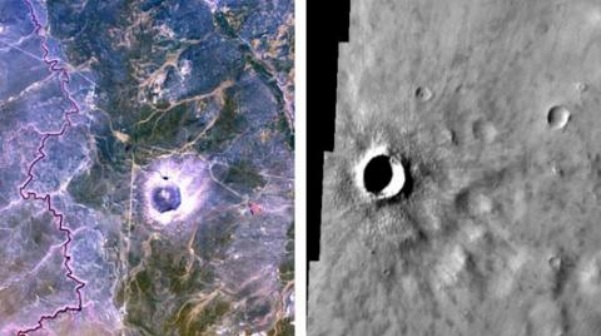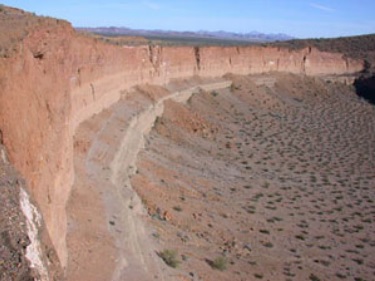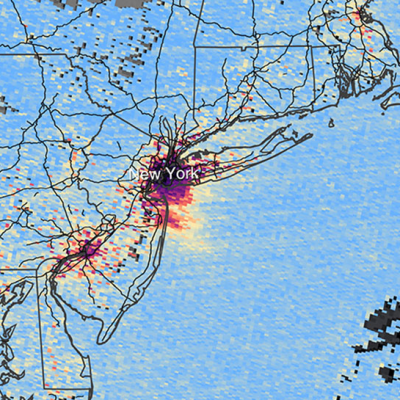At first glance, Mars and Earth are two very different planets. The desert-like landscape on Mars is stark, without vegetation, and seemingly lifeless. Its surface area is a mere one quarter that of Earth, yet its largest volcano, Olympus Mons, is three times the height of Mount Everest. And the average temperature on Mars is a frigid -63 degrees Celsius (-81 degrees F), while Earth's average temperature hovers around 15 degrees Celsius (59 degrees F).
But when it comes to geologic processes, the two worlds are surprisingly alike. And it's this similarity that is helping planetary scientists learn how to interpret high-resolution remote sensing data of the Martian surface. "Mars is a very similar planet to Earth," said Michael Ramsey, assistant professor in the Department of Geology and Planetary Science at the University of Pittsburgh. "We see wind streaks, volcanoes, water channels - pretty much the same geologic features that we see on Earth."
Ramsey is part of a research team developing techniques to accurately identify and analyze small features on the Martian surface in satellite images. "In the past, we've focused on the large volcanoes, the giant impact basins, and the big channels," said Ramsey, "but we've never really been able to look at the small things on Mars."
The "small things" that Ramsey and his team hope to shed light on are craters -- bowl-shaped depressions on a planetary surface that are typically caused by one of two processes. Impact craters form when a meteoroid, asteroid, or comet collides with a planet. Volcanic craters delineate vent areas at the summit of a volcano. "When you get down to small sizes, it's hard to tell the difference between a volcanic crater and an impact crater," said David Crown, senior scientist at the Planetary Science Institute in Tucson, Ariz., and a co-investigator on the project.
Ramsey and Crown are particularly interested in a type of volcanic crater known as a maar crater, which is created by a violent explosion that occurs as magma moves up toward the surface and hits groundwater or a body of surface water. Typically, magma that contains enough gas to erupt explosively forms a cinder cone, as debris accumulates around the volcano's vent. But if abundant water exists in the region of the volcano, the magma interacts with the water, causing highly explosive eruptions that build a maar rather than a cinder cone. "Maar craters are volcanic, but they're not volcanoes as you tend to think of them," said Ramsey. "It's basically a steam vent, and they look just like impact craters - a big hole in the ground with a lot of rocks around the outside."
The researchers hope to come up with criteria that will enable them to distinguish between impact craters and maar craters solely by looking at satellite data. "The goal is to look at small craters on Earth, both impact and volcanic, and study the differences so that as we get high-resolution images of Mars, we can make useful interpretations," said Crown.
On Earth, maar craters may fill with water to form a lake or pond. Because the presence of maar craters is a strong indication of water beneath the surface, the ability to identify them on Mars has important implications for understanding the planet's geologic history. "We're interested in craters that are potentially water-driven features, because that means there could be liquid water beneath the surface, which is a big deal for Mars exploration," said Ramsey.
In the past, most scientists believed that Mars' volcanic activity was most intense in its ancient past. "The belief has been that Mars was really active in its early time (its first billion years), and that the last three billion years have been relatively quiet," Ramsey said. But the ability to now see smaller things on the Martian surface may change existing beliefs about the planet's geologic history.
One of the first things scientists do to estimate the age of a planetary surface is count the number of impact craters. "An old surface will have a lot more impact craters on it than a young surface," said Ramsey. "So if we find an area on Mars that only has one impact crater on it, that means it's a very young area."
Craters provide important clues into a planet's past, but Crown said the research community didn't pay much attention to small craters until fairly recently, as new high-resolution images of the Martian surface were acquired. "The whole idea of volcanic versus impact craters dates back to the early days of looking at the moon," he said. "Initially, scientists thought that the craters on the moon were due to gas bubbles coming out and blasting through the surface - that was actually in the scientific literature." Then in the 1960s, results of studies done at sites such as Meteor Crater in northern Arizona showed that the moon's craters were due to impacts, Crown said.
Although remote sensing on Mars is still in its infancy stage, using satellite data to identify surface land features on Earth is nothing new. Data from the Advanced Spaceborne Thermal Emission and Reflection Radiometer (ASTER), archived at NASA's Land Processes Distributed Active Archive Center (LP DAAC), have been used to study landforms on the surface of the Earth. Because of its high spatial resolution, ASTER enables researchers to see features that are relatively small. Ramsey, a member of the ASTER Science Team, has used ASTER data to study volcanic domes, fire scars, and urban growth. But on Earth, scientists can compare satellite imagery with ground data to verify their interpretations, in a process known as validation - something they can't do on Mars.
The Thermal Emission Imaging System (THEMIS), one of three instruments launched onboard the Mars Odyssey in April 2001, generates high-resolution data very similar to that of ASTER. Images from THEMIS helped NASA mission scientists choose landing sites for the Mars Exploration Rovers in 2003. One of the instrument's major mission goals is to study small-scale geologic processes on the Martian surface. But before scientists can begin to interpret the data from THEMIS, they have to be certain that what they think they're seeing is what's actually there.
Because ASTER and THEMIS generate data that are so similar in wavelength and pixel size, they offer an ideal comparison opportunity. "It's almost a perfect analog - like launching an instrument on Earth and an identical one on Mars, and then studying the results," said Ramsey.
So Ramsey, Crown, and their colleagues came up with a plan: If they could develop some techniques to accurately identify and examine impact and maar craters on Earth using ASTER data, then these same techniques could help them distinguish between the two crater types in satellite imagery of Mars and assess their geologic implications.
Since the ASTER and THEMIS instruments have very similar spatial and spectral resolutions in the VNIR and TI, data from ASTER can be used as an ideal analog for THEMIS data in studies of certain surface features, such as craters. (THEMIS images courtesy of NASA/JPL/Arizona State University; ASTER image courtesy of NASA/GSFC /METI/ERSDAC/JAROS and U.S./Japan ASTER Science Team).
The researchers chose two different crater sites on Earth - an impact crater and a maar crater - and set out to look for differences between the two, using both ASTER data and ground fieldwork.
Meteor Crater (also known as Barringer Crater), located in north-central Arizona, served as the impact crater study site. Known as one of the best-preserved impact craters on Earth, it is 180 meters (590 feet) deep and 1.2 kilometers (0.75 miles) in diameter. Arid climate and a lack of vegetation in the vicinity of Meteor Crater make it an excellent comparison site for similar-sized impact craters on Mars, Ramsey said.
Relatively close to Meteor Crater, just across the Mexican border from southern Arizona, lies the Pinacate Biosphere Reserve - home to a volcanic field and rare collection of maar craters. Measuring 1,400 meters (4,593 feet) wide, El Elegante Crater is the largest of these and was chosen as the maar crater study site. "The maar craters in Pinacate are almost the same age as Meteor Crater," said Ramsey, "so you basically have the same size craters in the same weathering environment."
The idea was to make comparisons between the ejecta (material thrown out of a crater during an explosion) they found at the rims of the two craters. "Since the walls of a crater are pretty vertical and don't show up in a satellite imagery, you have to concentrate on looking at the stuff that was thrown out," said Ramsey. "Then you can make inferences based on mapping the ejecta and rocks around the edge and in the general vicinity of the crater."
During two field campaigns in 2004 at both crater sites, the team, led by Ramsey and his graduate student Veronica Peet, created a dataset that included details about crater rim topography, block sizes and composition, and vegetation types and percentages - information that may reveal some definitive differences between the two crater types.
Although Ramsey is quick to point out that the study is still a work in progress, he said they already have some initial results. "Right now, we can't tell you that X, Y, and Z tells an impact and maar crater apart," he said. "We could end up with a null result that says they're just too similar to tell them apart using remote sensing data. But I don't think that's the case - we've already found some tantalizing differences."
One difference the team found relates to block size and location. "It appears that blocks at El Elegante Crater are bigger, on average, and are located closer to the crater rim than the blocks at Meteor Crater," said Ramsey. If the fieldwork results show this to be a consistent finding, it could serve as an important yardstick in telling the two crater types apart - on Earth and on Mars, the researchers said.
But the results are preliminary, and further comparisons need to be done. "You need to constantly calibrate what you see on the ground with what you see from space," said Crown. "It's a learning process - some things we see on the surface are expected, and others are a big surprise." Crown cited the example of the Martian "blueberries" photographed by the Mars rover Opportunity in December 2004. Blueberries are marble-sized pebbles that contain hematite, a mineral that supports the idea that water existed in Mars' past. "Nobody knew what that was going to look like," he said, "and every bit of new information can change things dramatically."
Understanding how to use satellite data to map subtle differences around a crater on Earth will give scientists a better handle on how to do it on Mars. But finding impact craters to study on Earth is like a complicated treasure hunt. Erosional processes and plate tectonics effectively erase impact craters from view. "If you look at the Earth's surface, your first impression would be that there are no impact craters on Earth. In reality, there are lots of older impact craters here, but they've been weathered away," said Ramsey.
While only about 120 impact craters have been identified on Earth, scientists estimate that on the surface of Mars, there are more than 43,000 impact craters with diameters greater than 5 kilometers (3 miles), and probably over a quarter of a million impact craters that are similar in size to Meteor Crater. Scientists believe that most craters on Mars were formed by meteorite impact early in Mars' history, but some may be from more recent impacts.
"Things on Mars stay around a lot longer than on Earth. You don't have plate tectonics erasing things as they go down a subduction zone," said Ramsey. "So our intent is to do the best we can making comparisons with these two craters, come up with some classifications, and then go to work on the THEMIS data from Mars."
Learning about small-scale processes on Mars can also provide valuable clues into the planet's climate history. "I don't think there's any question that there's water and ice near the Martian surface," said Crown. "The question is, 'what does this say about the climate history of the planet?' Does the existence of water on Mars in its earlier history mean that there was an atmosphere and a warmer planet? Or does it mean that there is just water locked up in the surface that sometimes gets released from the interior?" Answers to questions such as these could reveal information about Earth's future climate.
"It's all part of the big question: Why study the planets?" said Crown. "Trying to understand the history of other planets helps us compare them to the Earth and learn about patterns and geologic evolution on a planetary scale."
For now, the researchers continue to focus on one very small piece of the planetary geology puzzle: learning how to recognize different types of craters using satellite data. "We can't walk around to every crater on Mars and examine the material around the rims," said Ramsey. "Right now, we have to look at these features from space."
References
McGeary, D. and C.C. Plummer. 1992. Physical Geology, Earth Revealed . Wm. C. Brown Publishers.
Peet, V.M., M.S. Ramsey, and D.A. Crown. 2005. Comparison of terrestrial morphology, ejecta, and sediment transport of small craters: volcanic and impact analogs to Mars. Lunar Planet. Sci. Conf. #XXXVI , abs. #2080 (CD-ROM), 2005.
For more information
NASA Land Processes Distributed Active Archive Center (LP DAAC)
Image Visualization and Infrared Spectroscopy (IVIS) Laboratory
NASA's Mars Exploration Program
Advanced Spaceborne Thermal Emission and Reflection Radiometer (ASTER)
Thermal Emission Imaging System (THEMIS)
| About the remote sensing data used | ||
|---|---|---|
| Satellite | Terra | Thermal Emission Imaging System (THEMIS) |
| Sensor | Advanced Spaceborne Thermal Emission and Reflection Radiometer (ASTER) | Electric Field Instruments (EFIs) |
| Parameter | geography of Martian craters | geography of Martian craters |
| DAAC | NASA Land Processes Distributed Active Archive Center (LP DAAC) | NASA LP DAAC |
